Is it possible that a plant could change your life forever?
Yes it is possible that one plant could change your life forever and it could be just about any plant.
I really do mean that.
We had a very successful plant sale slash St. Patrick’s Day party this weekend at Mike’s Plant Farm here in Perry, Ohio and I had a bunch of Canadian Hemlock, botanical name Tsuga Canadensis in the field that had to be dug for the sale. As I was digging the plants I was thinking about how many opportunities just this one plant could provide for a person looking for something that is fun, rewarding and profitable.
As I explain what I mean I am going to put some photos in this post to show you how much fun we had and at the same time call out my assistant Amber. That’s her in the Leprechaun getup and no, I didn’t force her to do that. I suggested that we needed a Leprechaun for our party and next thing I know Amber had a box full of Irish party favors, decorations and a Leprechaun suite. That’s Amber!
But more importantly Amber and Cathy (remember this video) both have been incredibly important to my nursery this year. At the beginning of spring we did not have one single plant in a pot. Everything was in the ground. Today we have thousands and thousands of potted plants, tens of thousands of cuttings rooting and this past weekend those small plants sold like hot cakes. And for the most part, Amber and Cathy have done all of that potting and making and sticking cuttings.
Thank you so much both of you! You are the best!
Digging these trees is really hard work but at the same time it is very satisfying and peaceful and there is really nothing like being in a block of trees by yourself. The smell of the trees, the smell of the burlap, the sweat, the rain and the soil. And the reason that I am clearing this area is to give The Donkeys more room to graze.
You Should be Growing Canadian Hemlock from Seed.
As I was digging these Hemlocks I was thinking to myself; “I need to buy some more Hemlocks!” And that’s where you come in and that’s where this idea that a single plant could change your life forever comes from. You need to understand people like me, and there are thousands of us, are not willing or interested in growing plants from seed. We’re too impatient for that. We need to turn our plants over faster than that. We would much rather buy a plant that somebody else grew from seed, plant it out in the field and grow it on from there.
So this week I need to get on the phone and order some Hemlock seedlings. While I’m at it I’ll probably order several hundred White Pine Seedlings, several hundred Concolor Fir Seedlings along with several hundred Canadian Hemlock seedlings. Not to mention the thousands of other plants that I’ll buy between now and next spring. On the wholesale market you don’t sell a few plants at time. You sell hundreds of plants to people you’ll likely to never meet in person. All you do is pack them up in a box and ship them off.
Think about that. One phone call and I will place an order for about 600 plants and I’ll probably pay about $1.50 each for them. You could be the person getting that money, if only you had nice plants to sell. And here’s the thing. When I call to order plants, I almost always get carried away and end up ordering hundreds more than I intended to. And I’m never sorry later because they always sell.
This Canadian Hemlock is in my landscape. Once a year, usually late summer, I trim it up tightly so it doesn’t out grow the landscape and at the same time the more I trim it the tighter and fuller it gets. You’ll notice in the other photos the Hemlocks that I am digging haven’t been trimmed since last fall and they have that soft, feathery look to them.
The Hemlock that I dug this week are from 36″ to 48″ tall but as I was digging them I was thinking how easy it would be to sell them right in the ground if only I had grown them on to a size of about 7′. It’s really hard for landscapers and re-wholesalers to find big evergreens because most growers dig and sell them at smaller sizes. So the larger trees really bring a premium price. And since they are so scarce you can often find a buyer that is not only willing to buy them, but they are also willing to send a crew to your nursery to dig them.
Many times I have sold plants right in the ground. I tell that story here.
All you do is grow them, keep them trimmed, sprayed if needed and cultivate around them so the weeds don’t ruin them. If you have really nice trees, some wholesale buyer is certainly going to be interested in your trees and willing to arrange to have them dug. At least that’s the case around here, but truth be told, these wholesale buyers will travel a long way to find the plants they need if the price is right. It’s not at all unusual for them to go into another state to get what they need. Actually, it’s pretty common.
But . . . that’s not what I wanted to talk to you about today. Today I want to keep it simple and explain to you how easy it would be to sell Canadian Hemlock seedlings if you had them. Seedlings are great because they take up very little room and all you have to do is grow them, harvest them, pack them in box and ship them off to your customer.
Canadian Hemlock are Easy to Grow from Seed.
1. Get yourself some seed. There are two ways to get seed. You can buy seed, there are companies that sell all kinds of seeds and several of these wholesale seed suppliers are listed in the Wholesale Directory that come with My Backyard Growing System. Or you can collect the seed yourself from trees in your neighborhood. Canadian Hemlocks produce cones like pine cones.
The seeds are trapped inside of those cones. In the fall the cones start to dry out and open and as they do the seeds are released. Be careful not to harvest the pine cones too soon. You have to wait for the seeds inside of the cones to mature. As the cones start to change in color from a light green to a brown the seeds are mature. Collect the cones and place them in a brown paper bag. When the cones dry and open the seeds will be released into the bag where you can easily collect them.
Hey! How about I throw in a digging lesson while I tell this story?
2. You have to stratify the seeds before they’ll germinate. When the seeds are released from the cones they are in a dormant state and need a little wake up call. My recommendation is to soak the seeds in warm (not hot) water for 24 hours, take them out of the water and spread them out on paper towels and let them dry for about 24 hours.
3. Fill a flat with potting soil that drains well. Sow the seeds on top of the soil then gently press the seeds down so they make good contact with the soil in the flat. Sprinkle a light layer of soil over the seeds and place the flat outside in a shaded area. Gently water the flat, making sure that the soil is nice and moist. Keep in mind, you are doing this in the fall. The seeds will not germinate until spring, but leaving them out in the cold is part of the stratification process.
4. This is important! Cover the flat with a piece of window screen or hardware cloth. Use bricks or something else heavy to hold the screen in place. The purpose of the screen is to keep critters and varmints from digging in the flat and eating the seeds. Over the winter keep the seeds watered as needed. Not soggy! Just watered as needed so the potting mix is moist but not wet.
5. Come spring remove the screen so the seedlings can grow.
6. Once the seedlings are a few inches tall they can be transplanted out of the flat into small pots or into a bed. Be careful not to damage roots when transplanting. If you want you can just leave the seedlings in the flat until late fall. By then they will be hardened off and will be getting ready for winter so transplanting them will be less risky and even if you do break some roots it won’t upset them like it would during the growing season.
Keep in mind, when trees are grown from seed they like to make one long tap root and that’s not really what you want. When a wholesale buyer buys tree seedlings they want plants with nice full root systems, a nice little root ball is what they are looking for. Not a seedling with one really long root.
On a seedling a root ball is created by root pruning, or transplanting your seedlings. Growers love to buy seedlings that have been transplanted at least once if not twice because the more times a seedling has been transplanted that means that the roots have been trimmed that many times, assuring a nice full root ball.
Today growers who produce the best quality tree seedlings grow them in pots that automatically root prune them via a process known as air pruning. Some of these pots are bottomless, others have large slits in the sides. As the roots reach these openings and start to grow through the openings the air actually kills the tip of the tiny roots which is the same as the root being pruned. But it’s done at the earliest stage possible and really at the ideal time because the roots never get a chance to start circling the inside of the container which creates a root bound plant.
Each time the tip of the roots is killed via air pruning that forces more lateral roots within the root ball which is exactly what you want, and exactly what your wholesale customers want.
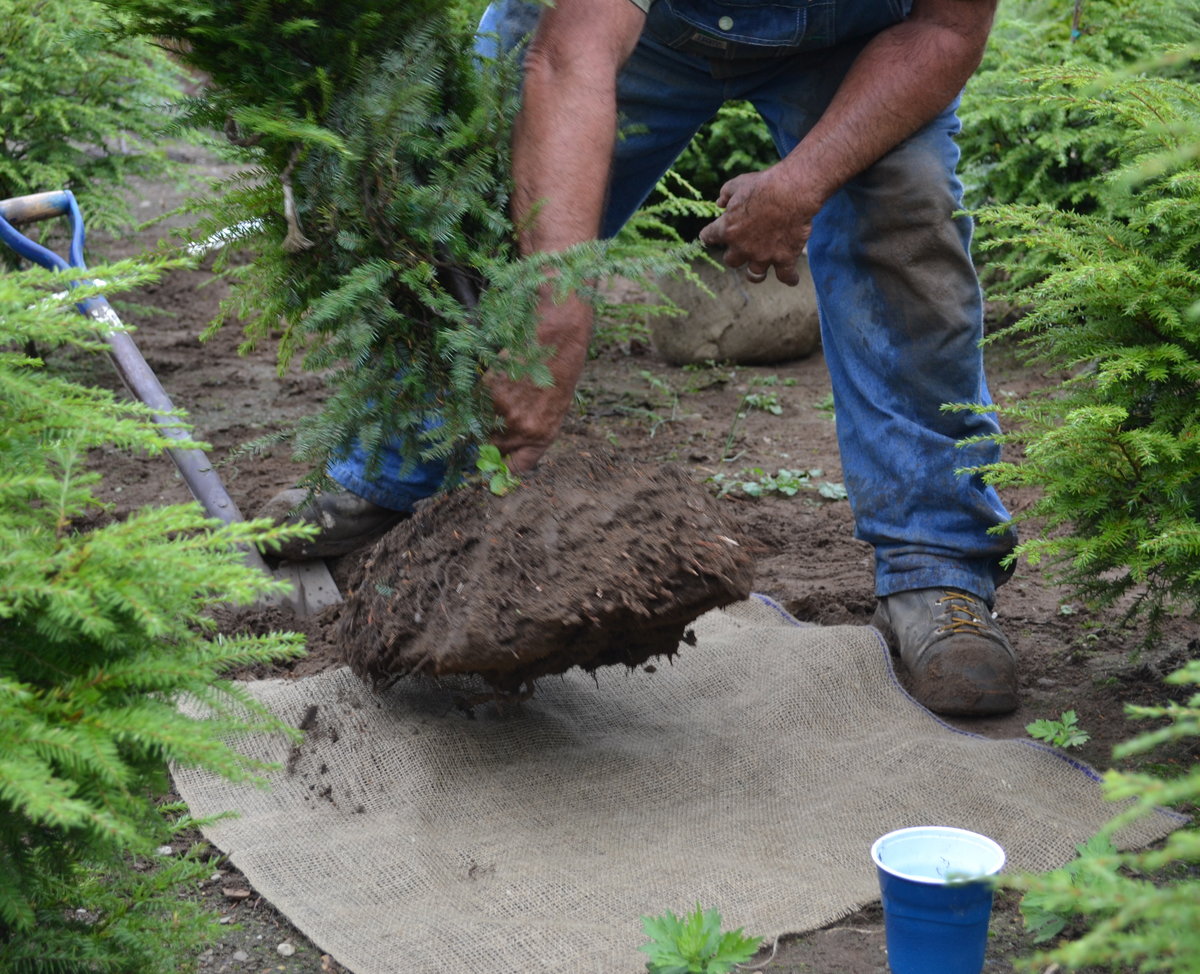
As the ball comes out of the hole it’s obvious that the bottom of the ball broke loose. Some soil is placed on the burlap to make up for this loss of soil.
4. Another thing to keep in mind is that not only do wholesale buyers want a seedling that has a nice full root ball, they also want a plant that has tight, compact top top growth. Compact top growth is achieved the same way, by pruning the tops as need so you don’t end up with a 15″ tall seedling that is so lanky it just falls over.
Growing Canadian Hemlock, Tsuga Canadensis from Cuttings.
Canadian Hemlock are not typically grown from cuttings because they are difficult to do from cuttings. It takes them many weeks if not months to root if they root at all. The best way to do them from cuttings is in the late fall or winter when the growth has hardened off. But even then, you really have to use bottom heat to heat the rooting medium but not the air around the top of the cuttings.
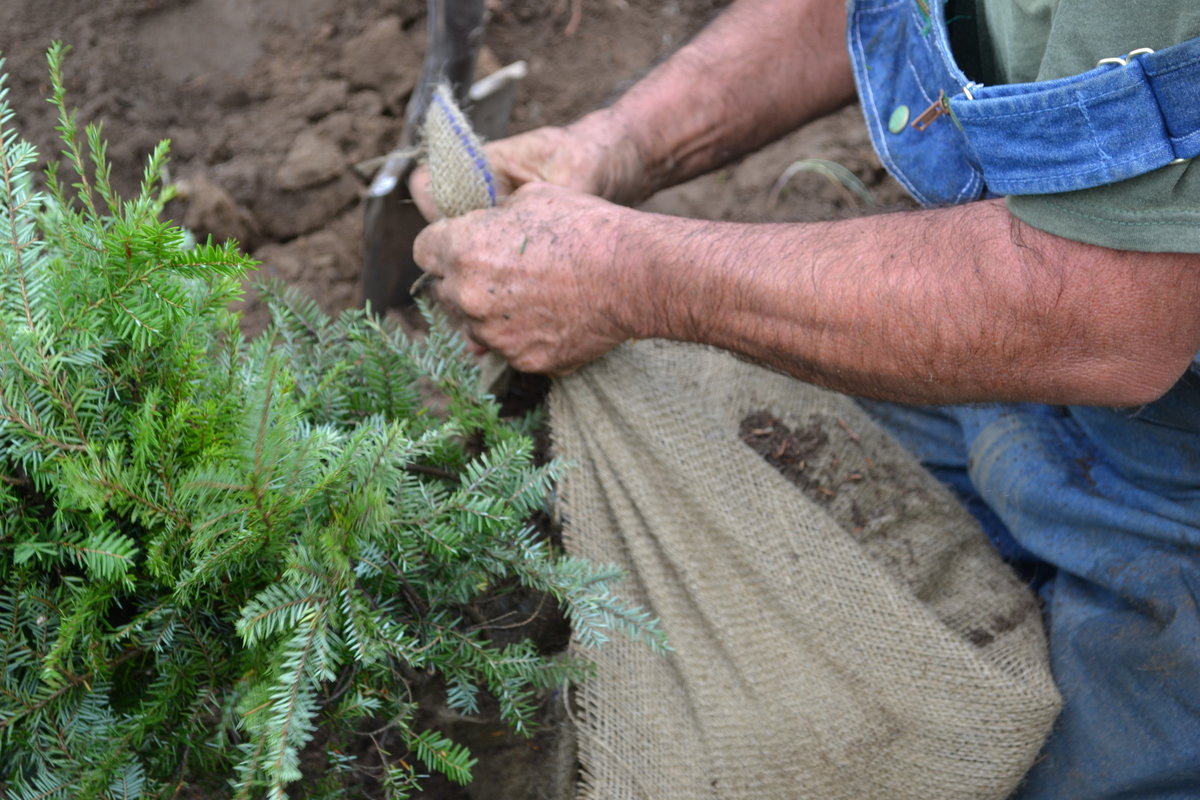
The next step is to tie the opposite corners of the burlap so there are two knots on top of the root ball.
Bottom heat is usually creating using soil warming cables or horticultural heating mats. I suppose if you got good at doing them from cuttings there would be a nice market for rooted cuttings. However, I’m not one for reinventing the wheel so I just pay close attention to what the established wholesale growers do. They do lots of things over bottom heat but Canadian Hemlock is not one. And I can assure you, there’s a reason for that.

It’s important to pat the ball like a baby’s bottom so as you pin the burlap it pulls nice and tight. Ball and Burlaping Canadian Hemlock.
I can assure you, the market for good quality tree seedlings is huge, bigger than you can possibly imagine. And as is the case for all kinds of rooted cuttings. Evergreens, flowering shrubs, fruit plants etc. The possibilities are endless.
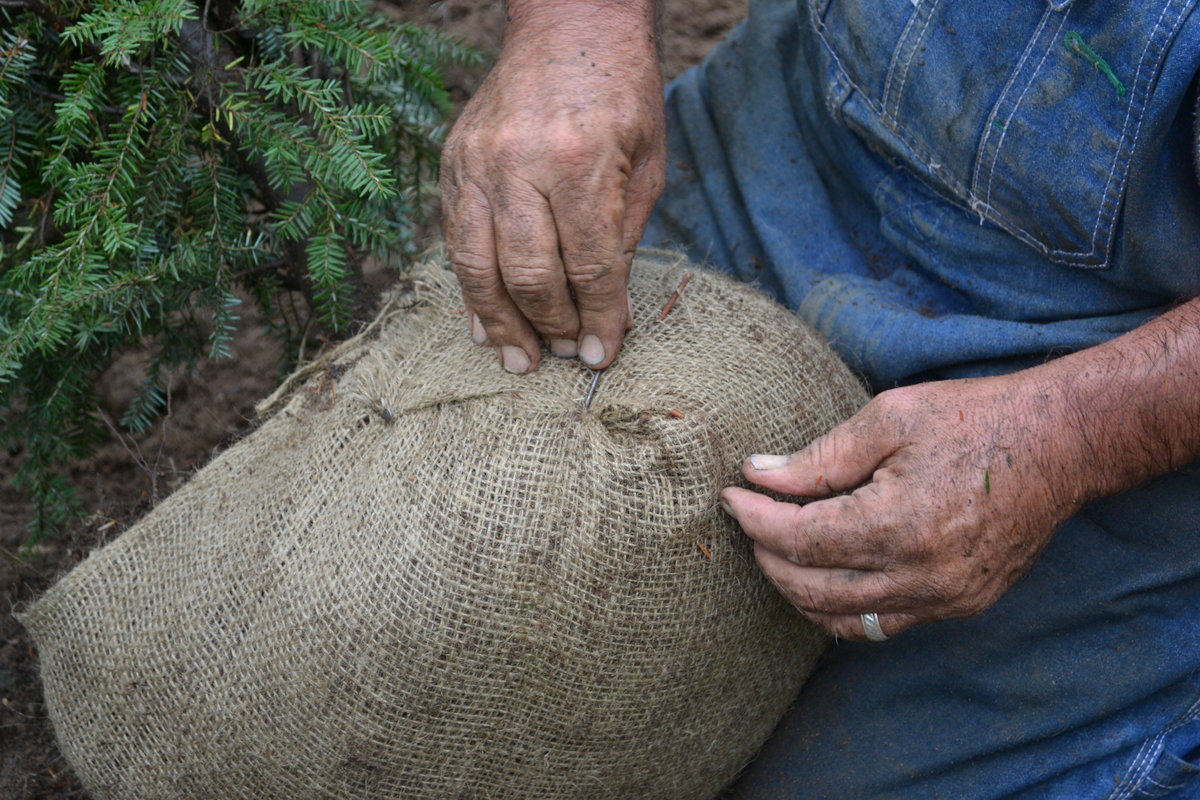
Pinning the ball is critical. You have to use the pinning nail to get leverage to pull the burlap tight.
Here’s a million dollar tip. Only bring with you to the field enough pinning nails to do the job. Never, ever carry a full box of nails or a pail of nails into the field. Know why? I’ll bet you’re wrong. First person to guess why that’s such a valuable tip gets
a free copy of my book “Easy Plant Propagation”.
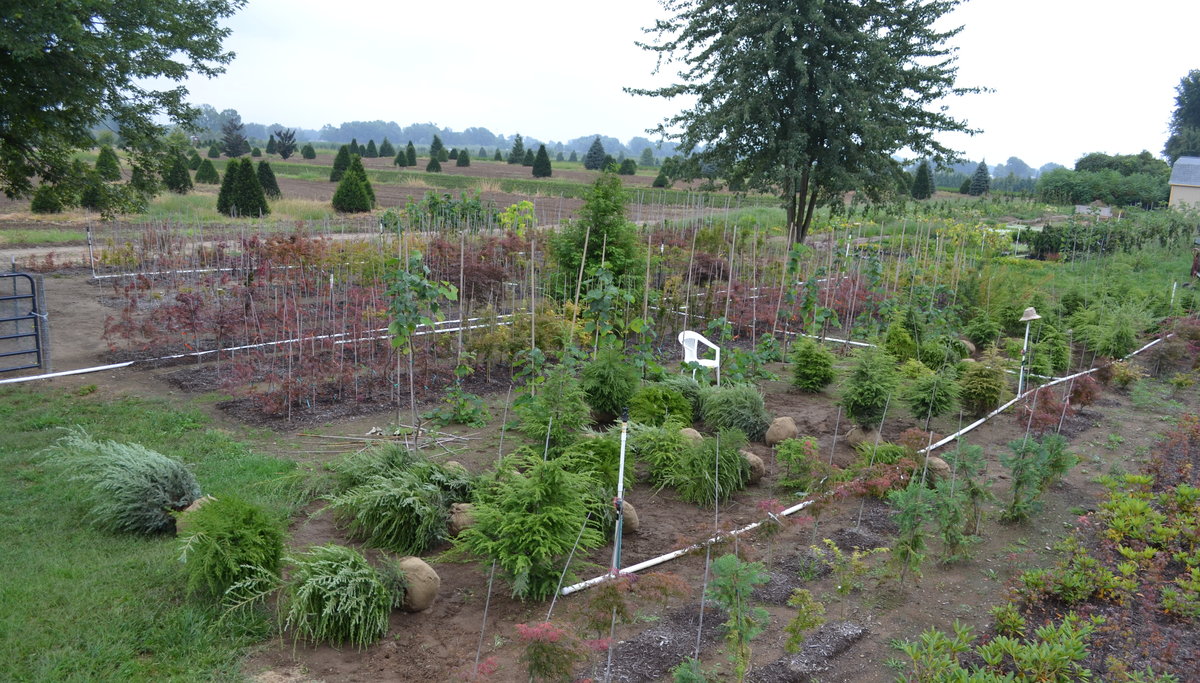
My little nursery is sandwiched between two dirt farm roads with nurseries on either side of me, another behind my property and at least 83 other nurseries in a 15 mile radius around my property. And you’re worried about competition?
See the chair in the middle of the field? It’s there for two reasons. One, I’m 57 years old and delighted to be able to dig all of those trees at my age, but I do rest when tired. Secondly, the first day I started digging these trees it was 94 degrees in September. The chair got a lot of use that day! Oh, and I see I must have hung my hat on a sprinkler. Better go get that.
I’ve got two videos that are related to the digging of these hemlocks. As soon as we get them uploaded to youtube I’ll link to them right smack here. I was on a mission to get these Hemlocks dug because this winter I will be expanding the donkey pen, they need room to romp around. I already said that didn’t I? I forgot because I’ve spent hours on this post editing photos etc.
Questions, comments? Did you see my little challenge? Do you have the answer?
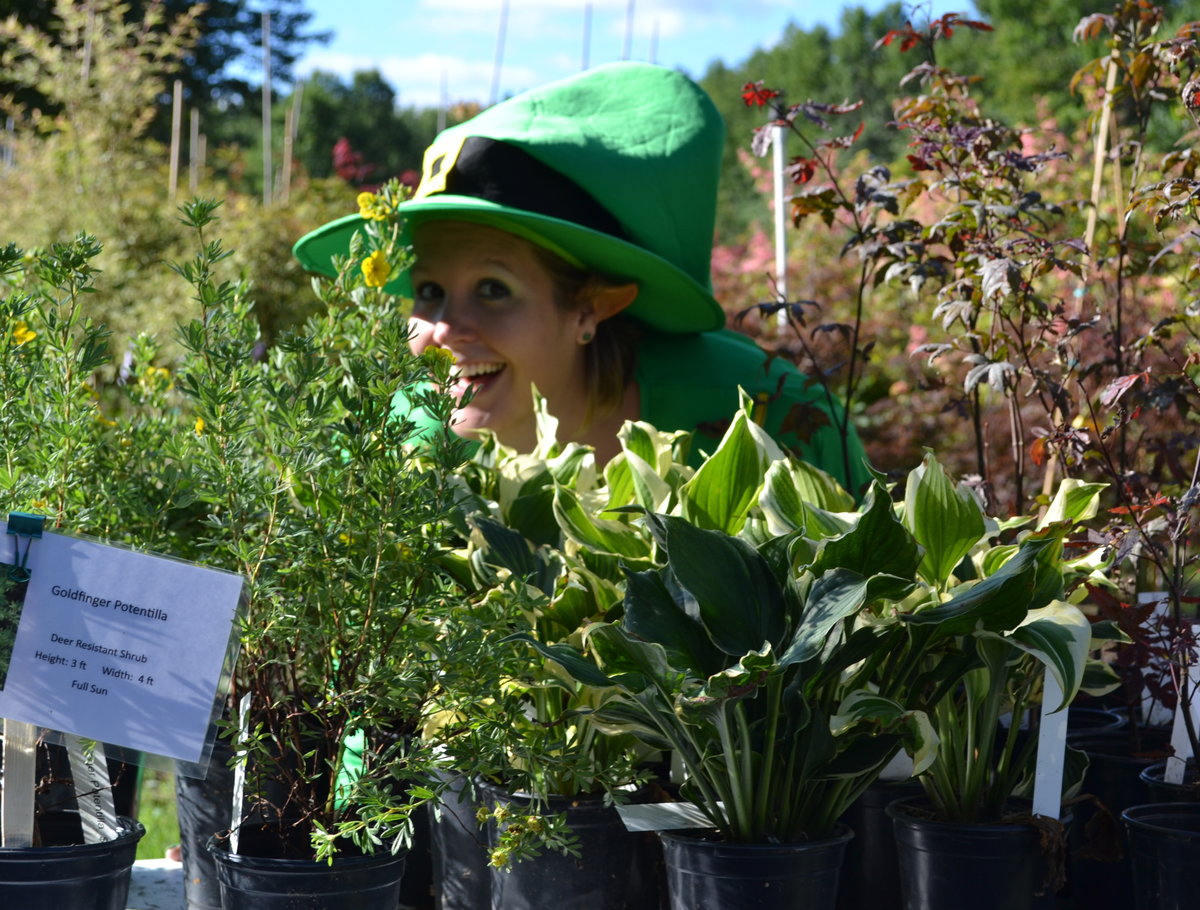
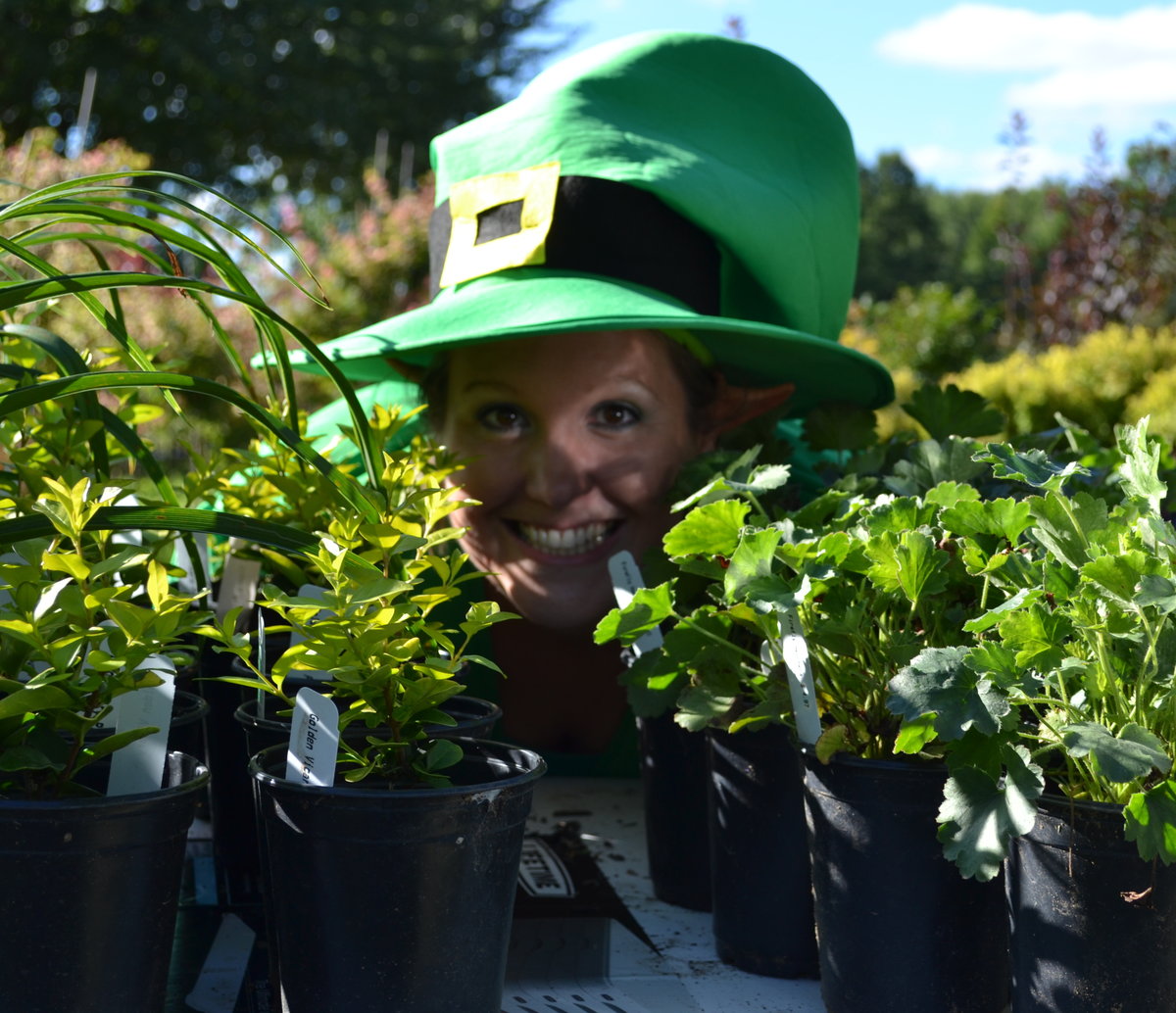
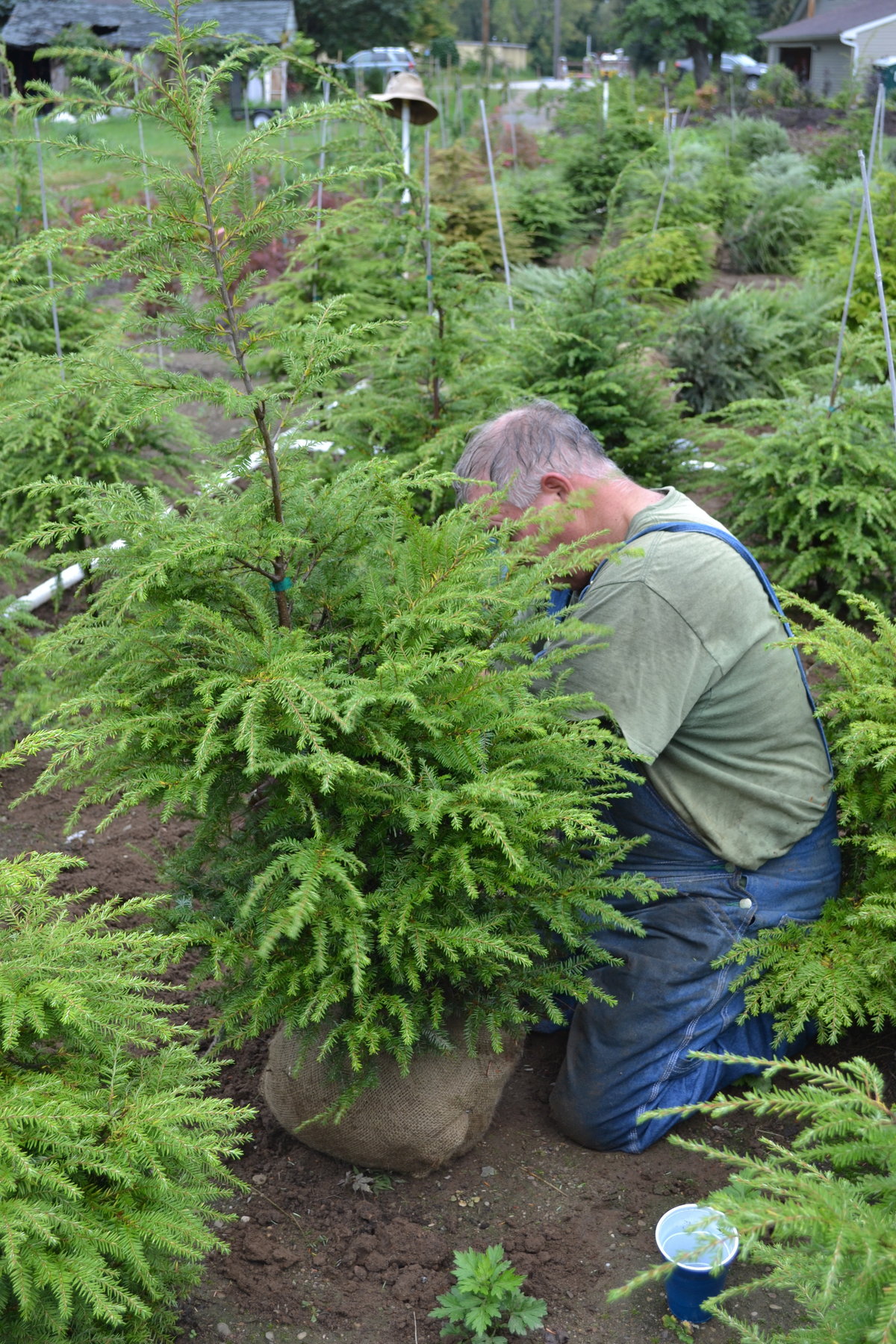

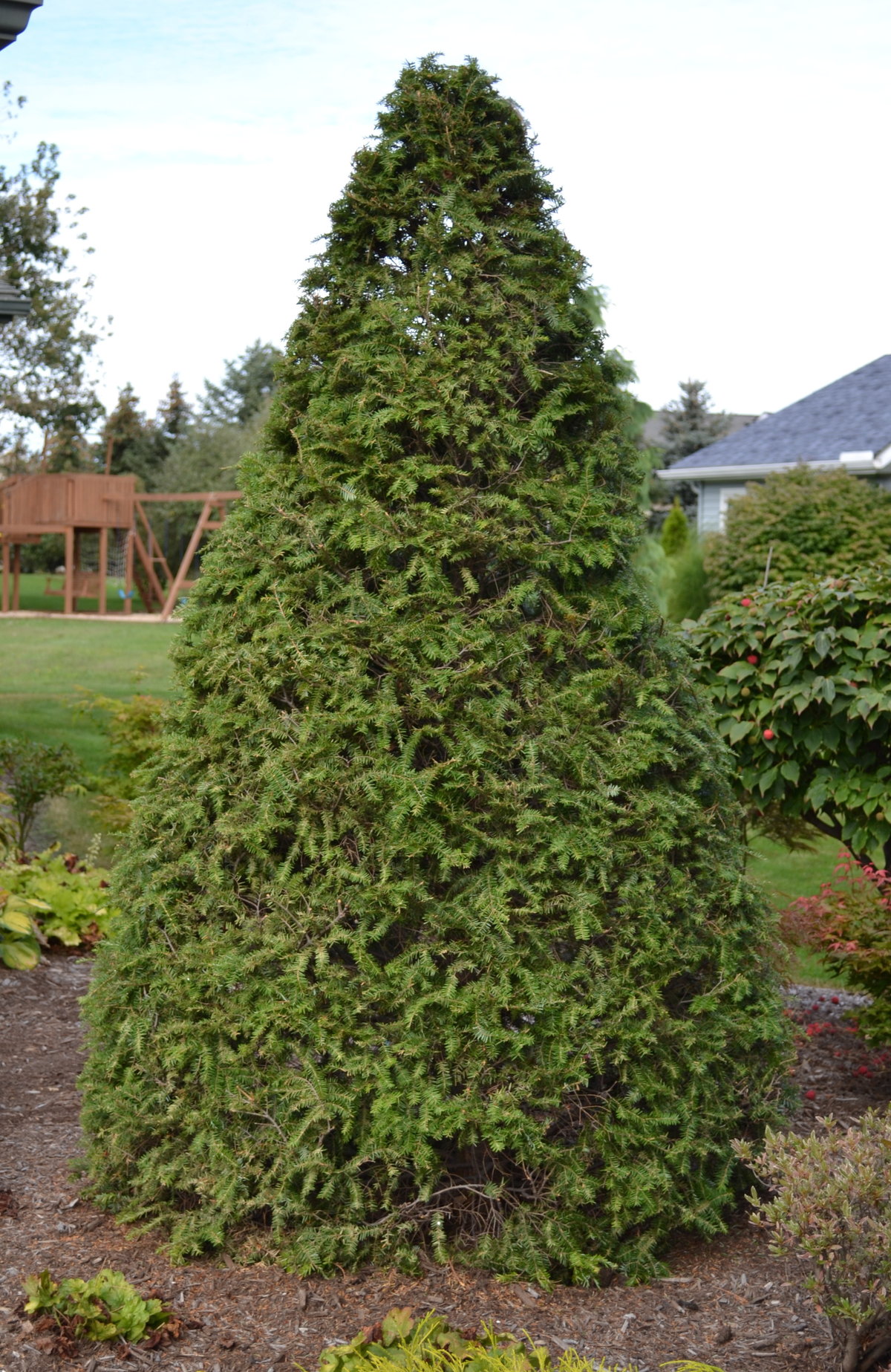
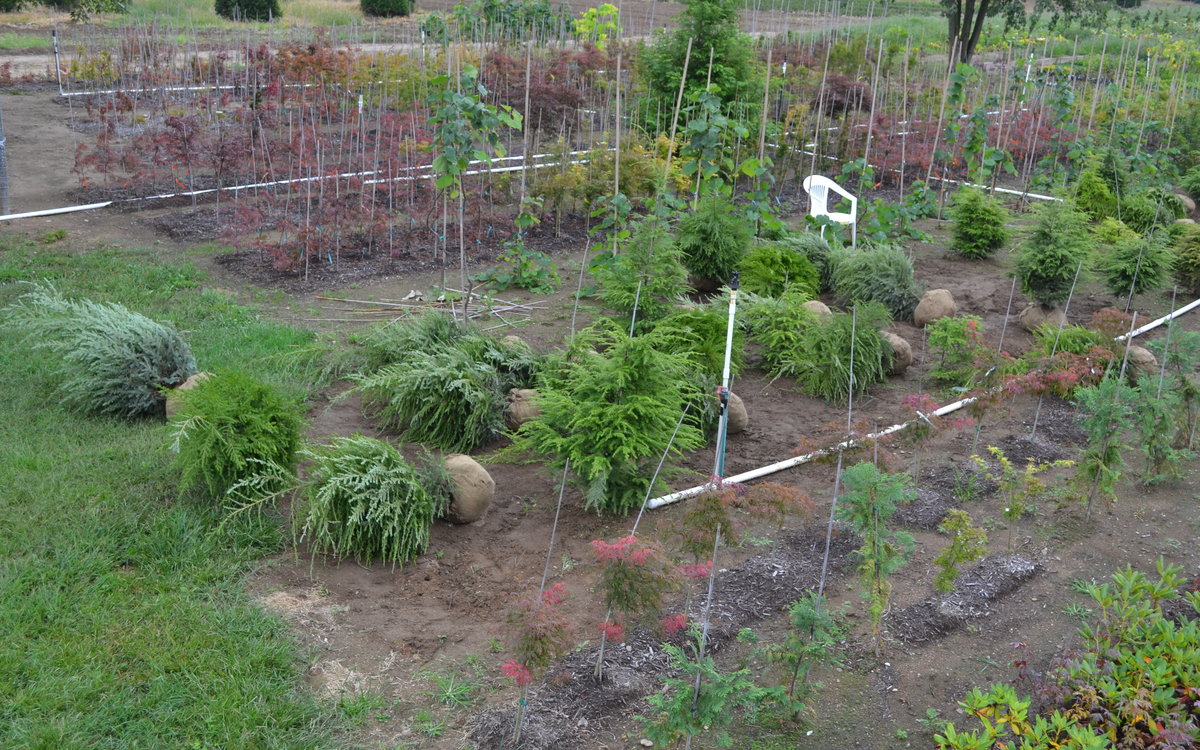
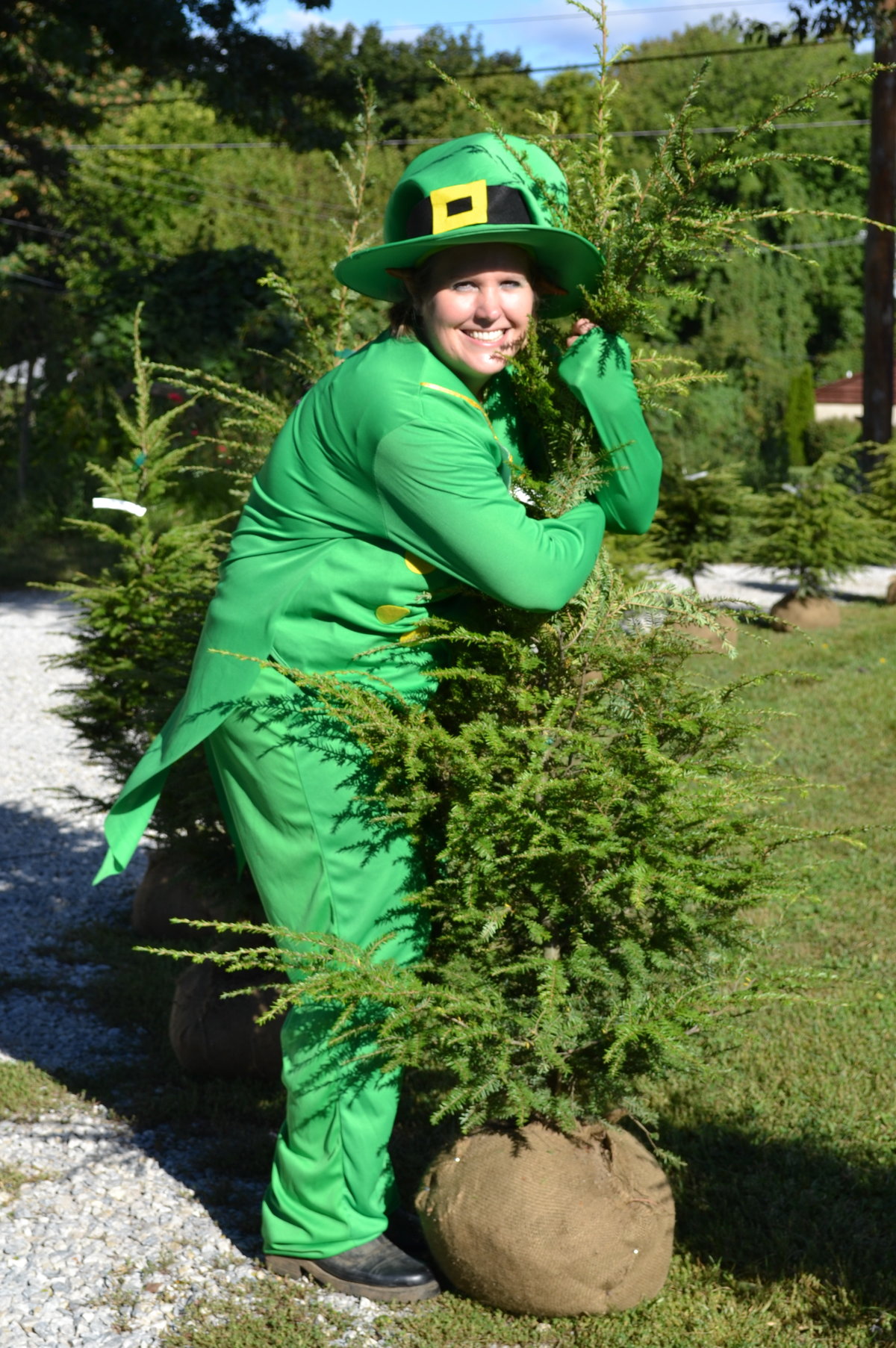

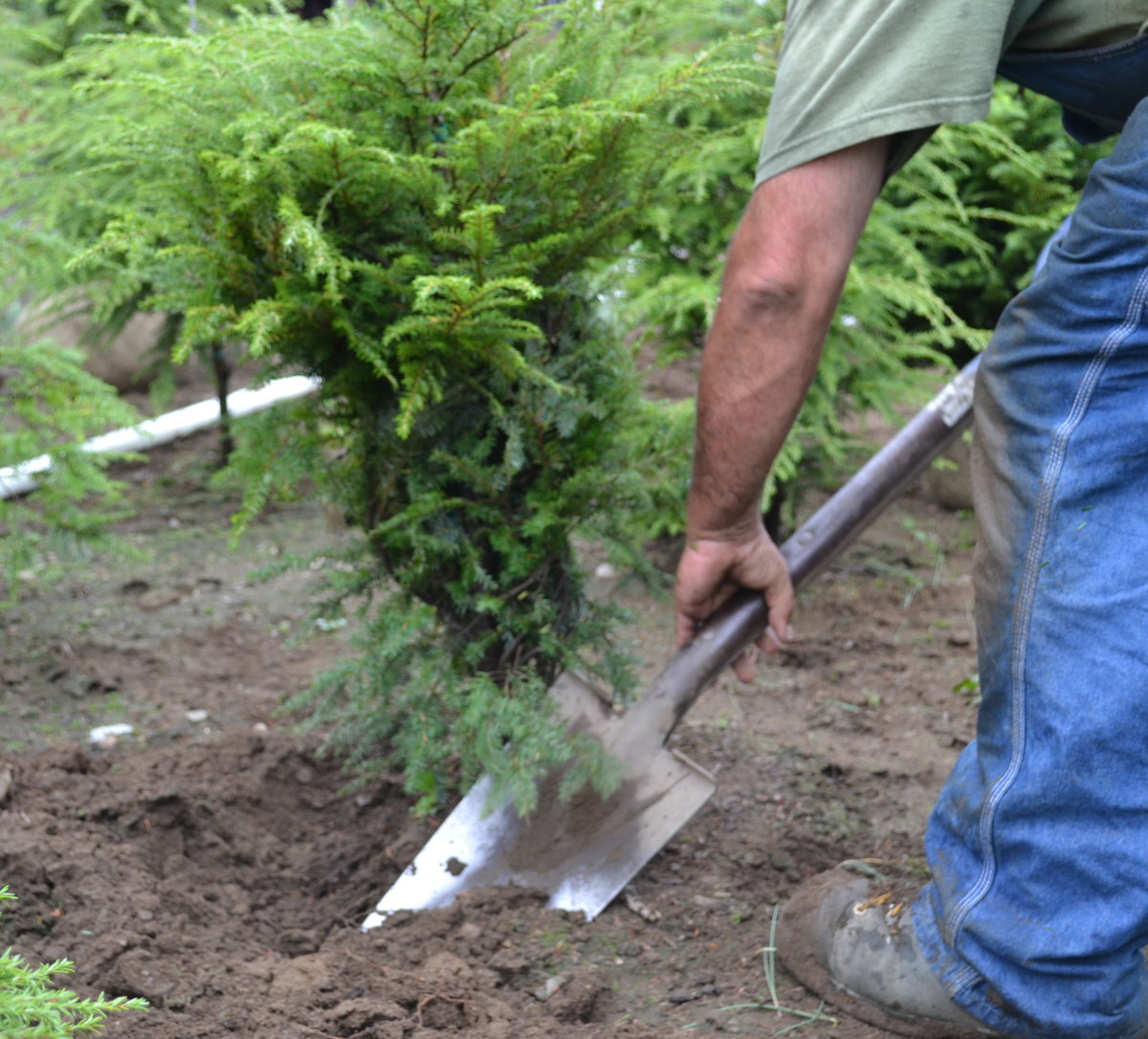
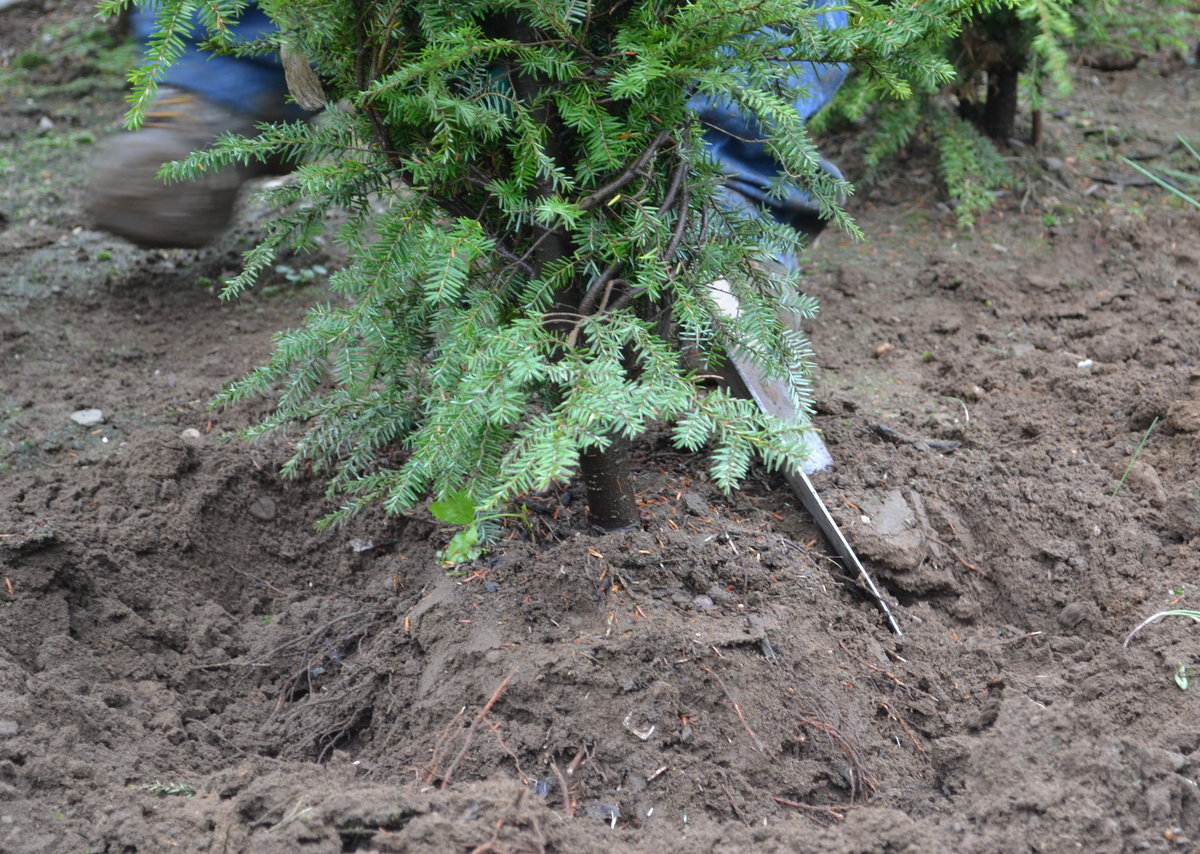
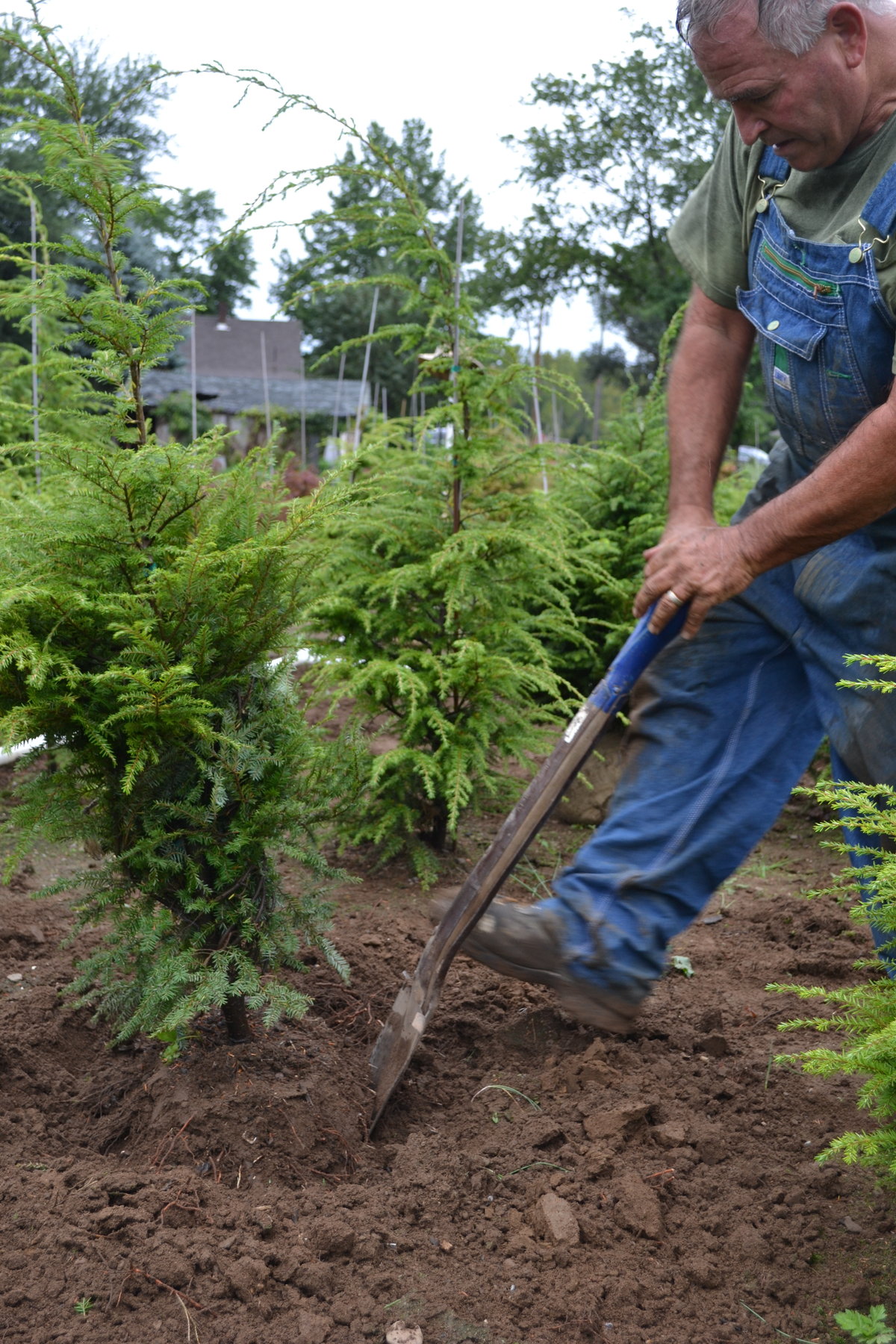
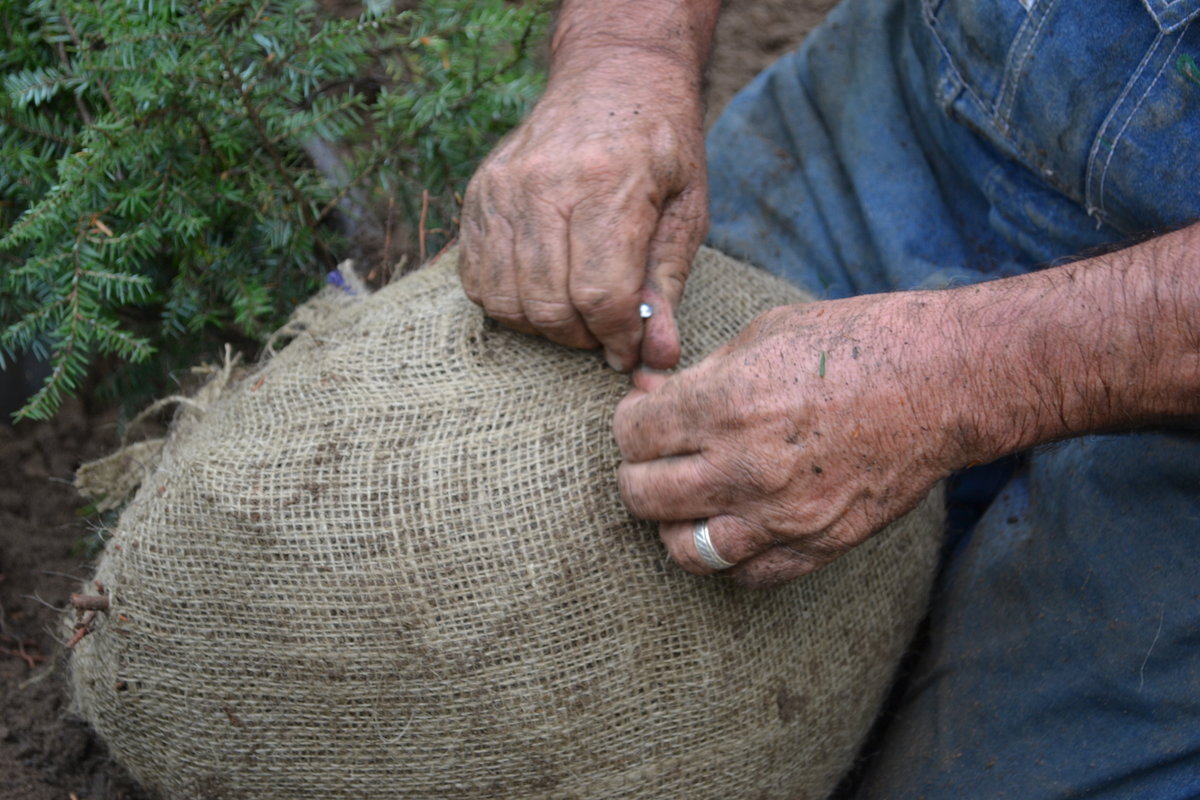
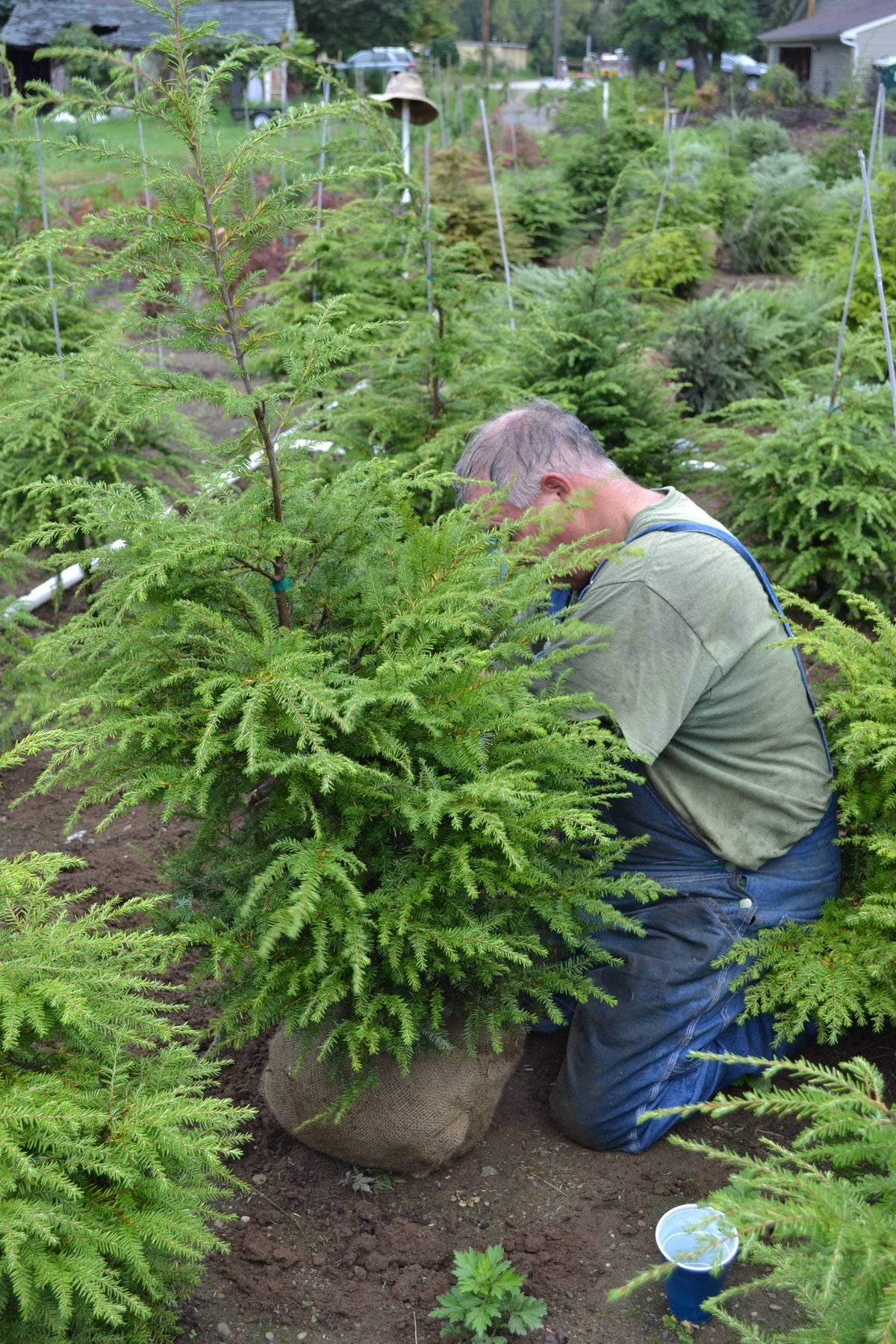
Hi Mike, I have some hemlock seeds I am going to grow, and I have a few questions. 1. Can I grow them in full sun? I’ve always heard they like shade, but I moved one into the sun in the spring, and it died. 2. Can I grow them in regular pots instead of flats? I don’t have any yet, and I usually don’t have any access to them untill late January-early February. Lastly, is ther any way to protect them from the hemlock wooly adelgid? I have actually seen hemlock trees dying from it not far from my house. Thanks!
Ethan,
Hemlocks are an understory tree that will tolerate shade pretty well for an evergreen but they will grow quite well in full sun. However, most seedlings like some shade for the first year or two. I’m sure you can spray the trees to protect them, more here http://extension.umass.edu/landscape/fact-sheets/hemlock-woolly-adelgid-frequently-asked-questions
hey mike, I truly enjoy the information you share pertaining to plant material. I’ve got a bachelors degree in plant science and horticultural design, so plants run through my xylem always have! as far as the nails I’m gonna say you would not want a box of nails to get damp in the field and have the bottom fall out. also using only what you need for the job cuts cost, expecting cost per plant is where you make money! thanks, joe
Thanks Joe, you are right about a box of damp nails because a rusty nail cannot be pushed through the burlap without a lot of effort.
I really enjoy all the information you give to everyone! I have a small greenhouse already that my nephew and I grown flowers in. We’ve never gotten into the tree business but really sounds like we could make some money doing it. I’m really thinking seriously about getting your growing system.
Thanks so much for helping so many people out and answering questions! You must be exhausted by the time the day ends every day!
Thanks Donna, it is time consuming. What you see is only part of the questions that I answer. There are a lot more!
Hi Mike
I’ve just ordered the “Small Plants, Big Profits from Home” and have been reading your blog for some time now. I’m very excited to get started and think this really could be a great opportunity for me. I must say that I truly appreciate your enthusiasm and generosity in sharing your knowledge with us. You’ve inspired me to take a leap of faith and make this happen for my future. I recently moved to my Aunt’s horse farm where I will be starting my “backyard” plant business and my question is regarding horse manure. As you can imagine there is an abundance of it and there are some areas where it was spread out nd has broken down and looks like rich soil. Would you know how much of this I can add to a potting soil mixture? My Aunt swears by it and says it doesn’t burn plants the way cow manure would.I’m hoping to mix up my own potting soil, but am not sure how. I’m told the soil in our area has alot of clay in it. Any insights on this would be a great help.
Thanks for all your great info.
Claudia
Claudia,
Horse manure is great but it should be well composted before you use it to make sure that all of the weed seed in the manure is spent before you add it to any growing mix. How much you add to a potting mix really has to do with drainage. Too much and mix won’t drain fast enough. Horse manure is really good in a bed if you are going to grow plants in the ground.
Thanks Mike. I appreciate your quick response. Have a great day!
I signed up for your newsletter a few months ago and follow it faithfully. I also bought the book and the backyard growers course and Leo’s “Start your website course”. There is so much information that I am looking forward to the winter to study it all again. I didn’t receive the list of wholesale growers from the digital book. I have been underlining them from your blogs and the course you sent me. If you take your course off site will we still get your blogs? Can I get the list of wholesale growers before your site goes down? Please don’t be down for long. Your information and your attitude is so inspirational to me. Thanks for the pictures and the videos.
Susan,
Everything that you have access to will still be available including weekly updates from me, Duston and Amber. If you check your emails the very message you got from me after ordering gave you access to that wholesale directory. If you still need help just Email Amber and she will help you. She’ll need your name and address so she can confirm that you are a customer.
Great site and very informative. I am considering doing something very similar where I live, though probably with fruit trees. Building up my infrastructure till a sell my business and make a go of it full time. Excited to read more Mike.
Dear Mike,
thank you for your informational videos on yt which brought me here. I write you later when I want to know more about foresting in far east.
Some years ago I tried to install American Redpines in Mongolia out of seeds, from 250 pieces 3 trees came up.
Best wishes from Germany!
Andreas
I have bought 3 (total) Big Beautiful Hemlock’s. I am in (Northern AL) right at zone 6 and 7. They all were doing great when I first planted them at my lake house …..then one week, I came up and the first one that I planted, my anniversary tree, was a pyramid of sticks. It went quickly. Nothing else was dry. Later I bought and planted 2 more. I was told by the farmer’s coop to pour a drench around the tree so that some kind of worm?? in the ground would not get to the roots. Did that. They looked great for almost 2 years. Then one day the one that had a lot of sun, but some shade, died a slow death. I still have one gorgeous Hemlock, but I am afraid to go to the lake for fear, it too will be dead. When the weather gets hot and dry, we do go up and water well, but we do not drown them. Why!!!! won’t my pretty and expensive trees live?
Glinda its not mike but i would say maybe this is coming from a 11 year old that maybe the soil is not right ask around see if the have had any luck hope that it helps:)
Mike its owen again i have many burning bush cuttings do you now any body in tennessee also where can i buy hemlock trees seeds remeber on a budget?
Thanks,
Owen
I sell them
Fascinating blog and terrific tips — thanks so much for the effort Mike! I look forward to your e-newsletter every month ~ despite being in S,A, & thus 6 months out of synch with you. You are an incredible inspiration to us Oldies (I am 67 ).
My question is – you are selling plants and/or trees + root balls + SOIL . So do you replenish your soil ever ? [Compost can only go so far ….] Or are you going to run out of this essential resource too, eventually ?
Marigold,
In this case I am selling a ball full of my topsoil. But at the same time I am getting away from this type of growing and all of my plants are going into small containers. Most growers replenish their fields with as much leaf compost as they can get and that seems to do the trick. They allow the general public to dispose of leaves at their nursery, that’s how they collect the leaves.
don’t put nails in a bucket because we don’t want mike to kick the bucket in the new donkey pasture lol
also,
Thanks for all the encouraging words you share about growing. I hope to have my own BY nursery soon.
Mike,
I just wanted to point out that at 10:37am Beverly Orris suggested the rusty pins before Mary. Well…..I guess she put two (“twofold”) answers, and the right answer was the 2nd one.
I like in Canada where Hemlock and Spruce grow wild in the bush. My grandfather used to show us how to tell a Hemlock from a Spruce. Hemlock needles are flat when rolled between the fingers and spruce needles are almost round. Hemlock needles lay flat on the branch and spruce needles encircle the branch.
Hemlocks are the REAL christmas trees here. The smell is wonderful.
Thanks for the newsletter.
Pam
Great stuff as usual Mike. Thanks for all you do! My guess is that if you only take enough to do the job you will pay more attention to detail and you will know where each nail is. Have a blessed day!
Thanks Ronnie, but not the answer that I am looking for.
Nails and donkey pens don’t mix
I have several Canadian hemlocks on my property. I almost lost him about five years ago to the woolly aldigid. This insect has destroyed thousands and thousands of hemlocks across the country over the past years. As you probably know there are forests totally bare that one time were full of Canadian hemlocks. For the longest time I decided never to grow them again until I was lucky enough to find something that killed those insects easily. Bayer makes a systemic food/poison to mix with water and pour around the base of the trees. Since my hemlocks are almost 60 feet high and the trunks are quite large I had to use quite a bit of this stuff to stop the infestation. It’s not cheap! However it is worth the expense and trouble to save your trees.
I’ve always wanted to propagate the hemlocks. I’ve used your cuttings method to no avail so far. I was very excited to see your information about growing them from seeds. Now that my trees are almost 20 years old they are having the pinecones you mention. very small Pinecones. Never really saw such tiny pinecones on any Evergreen. I plan on trying your method this fall and hope I am successful.
Thanks so much for the information. Oh, and thanks so much for all you do. Your videos are most informative.
Dave
Thanks Dave for sharing your experience with Hemlocks and the Wolly Adelgid. More here; http://www.ces.ncsu.edu/depts/ent/notes/O&T/trees/note119a/note119a.htm
I’ve just whined in a post about my dying Hemlocks. I guess the Wolly Bully was what the coop people sold me the drench for. How often do I need to use it?
Thanks for being so unselfish by sharing your tips. i have been following you for about 4yrs now.
Just purchased a home with a large enough yard so I can start some planting.
You’re welcome Donna, I love doing what I do! Have fun with that new home!
Thanks for the interesting article. Is it so the nails are all pointing downwards and you can grab them out of the cup without being pricked?
Do you ship plants to Canada
Gladys, no I don’t. Shipping across the border is not impossible but it does take extra paperwork. I have some backyard growers in Canada and we really need more so they can buy and sell to and from one another. http://mikesbackyardnursery.com/2013/03/how-to-make-65%C2%A2-per-square-inch-in-your-backyard/
I know that I would forget where I put them, and then I would step on them later.
Mike, what a beautiful tree. Really loved it. Not sure it would grow in this area too well. Remember the Weeping Cypress you showed us last year sometime? (Halloween tree), some people call it. I fell in love with this tree. Anyway, I’ve seen them all over the state of Washington, actually in the Kennewick area. Never seen one in my area, which is in Clearlake, Calif. I asked someone at one of our Nursery’s why. He said, we don’t have enough moisture up here. In the state of Washington, they have the Columbian River. Hear, it’s too dry. Interesting. Was a little disappointed. although, NOT SURE where I would put it anyway, our yard is full of beautiful trees and plants everywhere. Thanks Mike, for so much information about gardening. My favorite trees, are actually Japanese Maples. I have 4 of them in my patio. Linda,
Linda,
If you can grow Japanese maples, you can grow most anything including the Weeping Nootka Cypress. You have to be careful about advise that you get. It’s not all good. I could be wrong, but I don’t think so. I’m not in Washington either and our climate is nothing like theirs. Most of my Washington Growers struggle because of too much moisture much of the year.
My guess is the more nails you bring to the field, the more you will use.
Well, if I was the one pinning the trees, I might leave the bucket of nails out in the field somewhere. By the time I realized that I needed them again the bucket would be filled with rain water and the nails would be rusty. A blue or red colored solo cup stands out and is less likely to be left behind.
Would the nails change the pH of the soil if lost?
These sharp, little rascals can easily go through footware and tires. I’d guess it’s a safety issue.
Mike, I believe you shouldn’t carry more pinning nails than you would need because you may use too many on the burlap!
I also want to thank you for all you are doing. Your info/blogs have been so interesting and helpful.
I also have a question which I need help with. I have a Weeping Cyprus Nootka tree on my front lawn. It has been there for approx. 15 yrs. I noticed a while back that the branches facing north by the road are losing their foliage and several of the branches are bare from high up on the tree to its base.
I also have many hosta plants that are a mess. They seem to be disease ridden and I’m not sure what is happening.
Are you able to help me?
Thank you so much.
Elizabeth, London, Ontario
Elizabeth,
I don’t have a good answer. My first thought was salt spray from the road, but if it’s been there a long time this would have been a problem from the beginning. And maybe it’s far enough from the road not to get salt spray. The hostas I’d dig up and divide and they’ll probably thrive. At least I’d start there. Hosta does get a deadly virus but I’m not an expert on that.
Well, watching Mike pin the ball and seeing the size of the finished plant, I’d say you don’t want to carry any more than what you need because you’ll have to carry it back along with the plant when you’re done.
If you only take enough nails for the job, you will not use more than you need to complete it = less waste?
do you have coffee bean trees?
Mike, how about growing grapes. I am growing some for myself from cuttings and could easily start more. At the age of 70 I am only interested in growing small plants.
I have grapes also that haven’t been harvested or anything done in years –how do I get them to grow again or can cuttings be done? I am 60 and just now getting into doing some of Mike’s growing tips with plants and trees. thank you
Grapes are easily done as hardwood cuttings. You have to make the cuttings long because the buds are so far apart. I need to write more about his soon. There is a tutorial video about grapes on this site.
When you run out of what you have determined that you will need, you then know that you are done “pinning ” the root. If you want to o more, you can always grab for the next tree, when you remove the first one from the field. –seems good to use a cup with a god contrasting color, easier to find.
Pretty sure I’d end up dumping the box of nails if I took the whole thing out into the field I’d end up dumping it or crushing the box… Then I’d have a field of nails, and that’s no good for anyone!
I would never be able to take my truck into the field again without a flat tire.
I live in the mountains of North Carolina. We have hemlocks here and they are being attacked by an insect, the wolly adelgid, is the Canadian hemlock subject to attack by this insect?
Ct. Hemlock is almost all gawn it is sad to see RICK.
How about if you take your whole bucket of nails to the field soon you have half nails half dirt.Every time you get a nail out you leave soil in the bucket ?
I unearthed handful of rusty nails when planting perennial this year, left from a previous owner. If your pins are shiny, blackbirds may carry them off. If they get deep into soil, would they damage roots of small plants? If a person is barefoot, that would not be good either
I suspect my fellow readers have already named the reason, but I know from experience that if I took a big bucket into a field, I’d put it down and forget where I put it. Then I’d spend half the day looking for it next time I needed it. Great video, Mike! You are inspiring and I would like to do this one of these days… Maybe next year is my year!
Nails can get damp out in the field and if they rust it is hard to get them through the burlap when you are pinning the root balls.
Mary, you are awesome! This is exactly the answer that I was looking for! Tell Amber that you won a free book! [email protected] Only Mary is getting a book and we can only have one winner.
That is exactly right. There is nothing in the world worse than trying to push a rusty nail through burlap. I have to buy these pinning nails 50 lbs at a time, it would be a crime to ruin a whole box of them.
John said the answer to your question earlier than Mary, shouldn’t he be the winner?
Nails get hot in the sun. 🙂
I would not be able to grow like that in a field. I envy anyone with soil like that. I have never seen a pinning nail. Until I watched the video I thought maybe the nails were curved and would be bad to try to get hold of quickly but that don’t seem to be the case so I don’t know.
Perhaps you should only carry a few pins becuase if you drop or lose any the metal from the pins may leach into the ground and affect the soil?
The reason you only take what you need of pinning nails to the work site is, one you don’t want them falling out all over the place to puncture any tires, and two you don’t want them to get rusty because it makes it double hard to pin thru the burlap with rusty nails.
The more nails you carry out to the field the more canadian hemlocks you dig up and that’s a ton of work!
that way you can see at a quick glance as to how many more little trees are left to dig up.
I hope so anyway.
One day I may be able to grow some plants and start up my own backyard nursery…one day!!!
Nina,
Make this your goal. Write it down, post it where you can see it everyday. Read it daily and it will happen if you truly want it to. Do something everyday to get you closer to that goal. Put a dollar in jar for this purpose and add to it weekly.
Love this! Nina and I are in the same boat! One day…right now, its container extravaganza in a condo!!
Hi Mike…. thought you were done digging plants out in the field? It is in your blood for sure. You need to use a Rhino (atv) around the nursery. I use mine all the time, you would love it. I even pot my plants on the end of it, move my plants around the nursery with it, etc. …. Love your videos. Already a BYG member and would not trade it for the world! Keep those videos coming!
You know what Donna? You’re right. It is in my blood. I do want to get out of field production, but I’m not sure that will ever happen. There really isn’t too many other places that I’d like to be on most days.
Mike my guess is two fold:
first they will be no fun to pick up [and they will spill] and second
the more you have, the more you will use [raising the expense per plant]
bonus if you take them in the box, the box will get damp from the field conditions,
and and the pins will rust .. OR you’re back to reason # 1
I heard the solo cup get knocked over. I have the trouble of knocking even boxes of regular nails and screws over when I use them. I usually go to the shed and get my rare earth magnet (neodymium), that makes quick work of the pick up. Love the videos and hope they continue. Thanks for all the helpful info. Have a blessed day.
Thanks Horace!
Nice tip!
The magnet is a great tip! Even when using nails and such indoors. Getting myself one, and thanks, Horace!
My thought on the nails is the same as Susan… I also have a question…could you do a tutorial on pruning evergreens such as the hemlock, junipers and pine? Im familiar with general pruning rules on deciduous, however that word is spelled, but am clueless when to comes to these evergreens and those similar.
Thanks so much!! I enjoy reading your posts and appreciate you being down to earth.
Thanks Charity and you’re right, I need to do that. Remind me if I don’t.
I would think that if any did spill are get left behind it could cause a flat tire are get stuck in someones foot.
I run a farm with live stock on it. anything to do with Hemlock is very poisonous!!!
Thanks Lisa, I’ll have to look into that.
Don’t leave nails in field cause donkeys might eat them!
I would lose some here and there, maybe knock them over, or drop them. I want to only pick up a few in a cup instead of a pail that I knocked over. Also, they are heavy to tote around.